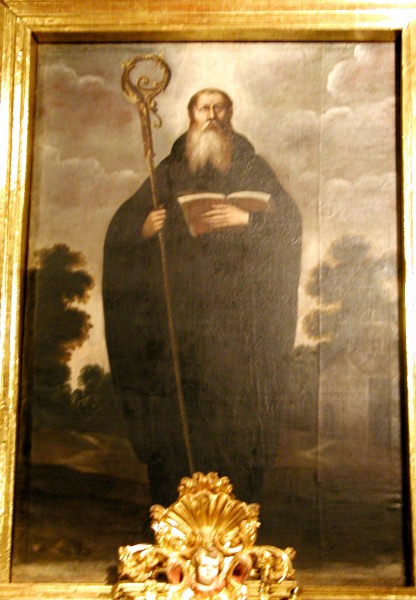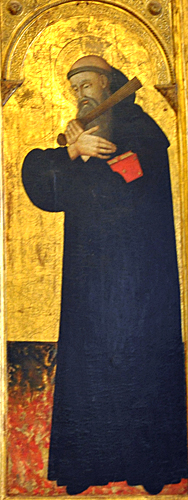In Benedict's time, and in the five centuries following, only bishops wore mitres; but starting in the 11th century the papacy authorized some abbots of important monasteries to wear them (Venables, 24). This may explain the appearance of mitres in some late images of Benedict. One example is in the Hours of Henry VIII (Wieck, 57) from 1480-1500; another is this painting from the 18th century.
The book is St. Benedict's Rule, the foundational document for thousands of religious communities in the middle ages. Many portraits have the book open to the first words of the Rule: Ausculta o fili precepta magistri, "Hear, o son, the precepts of the master" (example).
PORTRAITS
The earliest image of St. Benedict that I have yet seen is a 10th century fresco featuring one of the saint's miracles related by Gregory the Great. The fresco is in the 8th century church beneath San Crisogono in Trastevere. In it, the saint wears a black habit with a peaked cowl, as he does also in an 11th or 12th century ivory from the Veneto.
In later portraits the cowl is usually down, exposing a bald or tonsured pate. In late medieval images he usually has a forked white beard (example). Instead of a crozier he may carry a tied bundle of rods to symbolize the strength of monks who live together in a community, as in the second picture at right. A few images put him in a white habit (example), and in some narrative cycles his fellow monks also wear white (see below).
Occasionally a portrait will use some other attribute drawn from an episode in the hagiography – for example, a broken glass cup (example) refers to an episode of attempted poisoning, and a wine flagon (example) figures in another episode involving a flagon hidden away by one of the monks (See the Dialogues, II, xviii). A crow with a loaf in its mouth (example) refers to a poisoned loaf that an envious priest had sent to Benedict, which the saint told a crow to take away and dispose of safely.
NARRATIVE IMAGES
Benedict's life is recounted in the second book of Gregory the Great's 6th-century Dialogues. At first he was said to leave his comfortable home and shelter in a nearly inaccessible cell at the base of a tall cliff. A monk named Romanus would sometimes lower a loaf of bread for him from the top of the cliff, as pictured in a 1538 painting by the Master of Messkirch (One Hundred Saints, 147). Gregory tells of numerous miracles wrought by the saint in his lifetime, and during the Middle Ages a large number of image cycles depicted these miracles along with other episodes from Benedict's life. One of the most famous of them is Spinello Aretino's. Some others are listed at right.
There are also plenty of individual images of Benedict's miracles, such as his resuscitation of a dead boy and his recognition of King Totila.
Benedict's story is entwined with that of his sister St. Scholastica. See her page for details.
Prepared in 2014 by Richard Stracke, Emeritus Professor of English, Augusta University.
HOME PAGE

St. Benedict, 17th/18th century (See description page)

Detail from Nicola di Maestro Antonio, Triptych of the Annunciation, 15th century (See the description page)

This baroque-era santo of St. Benedict in a Mexican church has the traditional black cowled habit with a modern touch, a red nightcap. (See the description page)
MORE IMAGES
- 1390s: Cenni di Francesco's Coronation of the Virgin Altarpiece includes a miracle of St. Benedict in the predella and a portrait of the saint in the left wing.
-
1414: The predella of Lorenzo Monaco's Coronation of the Virgin with Saints has four panels on St. Benedict:
the exorcism of the errant monk,
the revival of the dead boy,
St. Maurus walking on water,
and the death of St. Benedict. -
1415: Nicolò di Pietro painted a set of four narrative images:
St. Benedict Exorcises a Possessed Monk,
St. Benedict and the Poisoned Wine,
St. Benedict and the Broken Sifter, and a fourth piece in which the devil tempts St. Benedict, which the museum label says is now in the Poldi Pezzoli Museum in Milan. - Circa 1420: Benedict welcomes Maurus into the monastic life in this miniature.
- 1475: Neroccio de' Landi's predella with three episodes: Romanus bringing Benedict bread, the sifter miracle, and the deception of Attila.
- Undated: A roundel with the face of St. Benedict, on the façade of the Ambrosian Basilica, Milan.
DATES
- Feast day: March 21
- Lived 480-550
- In 1969 the Roman Catholic Church changed St. Benedict's feast day from March 21 to July 11.
BIOGRAPHY
- Golden Legend #49: html or pdf
- Gregory the Great, Book II of the Dialogues.
- Stouck, 167-204
- Benedict's vita in The Roman Breviary: English translation, II, 769-70; Latin original, 840-41
- De Sancto Benedicto Abbate, Acta Sanctorum, March vol. 3, 274-357
- Carmen de Vita S. Benedicti, Analecta Bollandiana, XVII, 166-67.
ALSO SEE